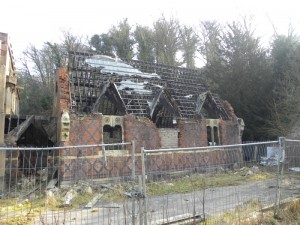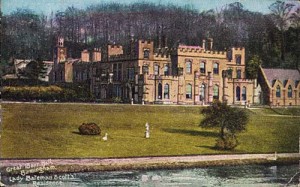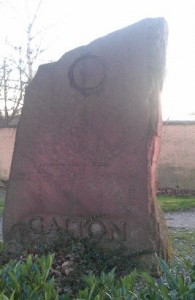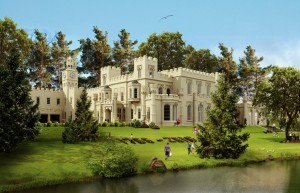Great Barr Hall
Great Barr Hall is a grade II listed gothic revival mansion lying in 170 acres of historic parkland on the greenbelt between Birmingham, Sandwell and Walsall. I grew up in the area and as a local resident I have always been interested in the history and future of the hall. It saddens me today that after many decades of neglect, the hall stands as a shadow of its former self, derelict, abused and in a desperate state of disrepair. It is now barely a shell of a building. On the English Heritage’s Buildings at Risk Register, the future of the house and its parkland currently hangs very much in the balance.
I wanted to write about Great Barr Hall for Birmingham Conservation Trust supporters as many may not even be aware of the hall’s existence. It is also a great local example of the challenges faced in the heritage sector today. Is it possible for historic buildings to be restored in a sustainable and sympathetic way whilst also balancing the needs of all the stakeholders involved? BCT’s Coffin Works Project hopes to achieve this, but is it just too late for Great Barr Hall? This is a brief overview of its story so far……
EARLY HISTORY.
The original house on the site, ‘Nether House’, had been in the Scott family since the early 17th century. By the mid-18th century the head of the family at that time, John Scott (1685-1755), had much improved the house and laid the foundation of the ornamental parkland. In 1777, Joseph Scott (1752–1828), rebuilt and extended the house to make a nine-bay, two storey rendered mansion, modelled on the Strawberry Hill Gothic Revival style.
Part of the house and some later improvements remain on the site today. For a more in-depth description of the hall’s architecture and surrounding landscape you can view the detailed English Heritage report here:
AN ILLUSTRIOUS PAST
From 1788, Joseph Scott found himself in financial difficulties due to his ambitious redevelopment of the hall. To ease his financial problems the property was leased out to the influential Birmingham banker and manufacturer Samuel Galton Jnr (1753-1832). During this period in its history, the hall became one of the favourite meeting places for the famous Lunar Society, a collection of prominent midland industrialists, philosophers and intellectuals, which included James Watt and Josiah Wedgewood. Nine lunar stones were commissioned to commemorate the members of the Lunar Society. These stones currently stand in the grounds of Asda Queslett, a short walk from Great Barr Hall.
Other notable people linked with Great Barr Hall include Humphry Repton (1752-1818) and John Nash (1752-1835), who were invited to continue to develop the site by the Scott family after Joseph Scott’s return to the hall and subsequent elevation to Baronetcy. The hall also had links to the Bronte family, as Lydia Robinson (nee Gisbourne) the wife of Edward Scott (2nd Baronet), was reputed to have had a previous love affair with Branwell Bronte when he worked in the household of her first husband. Indeed, when Lydia Scott became lady of Great Barr Hall the author Mrs Elizabeth Gaskell described Lydia as “Branwell Bronte’s paramour”, Mrs Scott threatened her with legal action!
THE HALL IN DECLINE
The Scott descendants continued to live in the house until the death of Lady Mildred Bateman-Scott in 1909. After her death the building was locked up for a couple of years before being auctioned and bought by the West Bromwich Board of Guardians.It was from this point that Great Barr Hall’s sad demise was set in motion. From 1918 the site was developed as a mental health hospital (at the time called ‘colony for mental defectives’ and later St Margaret Hospital). Unfortunately, the institutional nature of hospital use was not sympathetic to the hall and much damage was done to the original buildings and surrounding site. Notably in 1955 much of the old east wing was demolished, including the clock tower and stables block. In the 1960’s the beautiful gothic inspired oriel windows were ripped from the front of the hall and replaced by standard casement windows.
By 1978 the building had deteriorated further due to a continued lack of maintenance and was then abandoned for hospital use and vacated by staff. However, the building was not efficiently secured and as it lay deserted over the 1980’s, arson, vandalism and the elements caused much more extensive damage to the hall. In 1989, the hall and parkland were conveyed to a Mr Worth, a Birmingham financier and property developer. However, he didn’t manage to do any work to the hall other than stripping out plaster and dry rot, before the hall fell into receivership. It remained in the hands of the official receiver for more than 10 years.
The next stage in the hall’s history becomes quite complex and for a more detailed account please see the work of the historian Peter Allen and the Great Barr Action Committee. Over the 1990’s and early 2000’s much discussions and negotiations for the protection of the hall came to nothing. In 2003, the official receiver sold the site for under £900,000 to the Manor Preservation Trust. They then did a deal with Bovis Homes, who had a legal agreement with the official receivers tied in with development of adjacent land. In short what transpired was that controversially Bovis Homes successfully got planning permission to build an estate on part of the site, but the hall remained untouched as the Manor Building Preservation Trust failed to do any work to it. The Manor Trust then tried to sell the hall for £2.2 million, but it failed to sell for several years until a consortium of local businessmen brought the site in 2012.
THE NEW PLAN
The current owners have shown much promise in coming up with a plan for the hall and park. They have commissioned Lapworth architects to plan the renovation and rebuilding of the site, and have consulted with Walsall Planning Department, English Heritage, The Great Barr Hall Action Committee and Beacon Action Group, to come up with a plan that, they hope, will bring a sustainable future for the site. The planning application was made in November 2013 and it is currently pending approval, with a decision to be made in Autumn 2014. (Search for Walsall council planning: 13/1567/FL and 13/1567/LB).
In summary the main plans are:
- Creation of hotel/wedding conference centre/restaurant
- Restoration of the lawns to Great Barr Hall
- 2 gatehouse lodges
- A maintenance building/store
- 57 new dwellings
- Enhanced open space and nature conservation
- An acoustic barrier
- Boat and Summer house
- Demolition of farm buildings
- Dredging of lakes
- Reinstatement of bridge over lakes and installation of photovoltaic panels (alongside motorway).
The controversial aspect of this is more housing is to be built on the greenbelt land and that local people will have limited access to the remaining parkland (along with access, traffic congestion and noise concerns). However, funds from the proposed housing will be put back into the redevelopment of the hall and this time it is proposed that work on the new houses must be completed alongside the development of the hall.
English heritage have yet to comment fully on the proposal and on whether they offer their support to it. Given that the previous attempts to save the hall have failed, there is currently much debate on these new plans. Indeed, whilst some stakeholders are on the whole in favour of the plans, others are somewhat sceptical. The issue of Great Barr Hall and the greenbelt land it lies on continues to be a very emotive subject for many people. Following its years of abuse and neglect, I very much hope that a solution can be found and that Great Barr Hall will become a heritage success story. Only time will tell if this does happen. What is certain though, is that if something is not done soon, then what little is left of the hall will be lost forever.








I lived right by St Margarets hospital for all of my childhood and we went in the grounds regularly walking round Scott Hall. My mother worked there and even had an office in the hall at one stage.
However it was abused all the time and was the subject of many fires in the areas that had beautiful wood panels, however there was never any evidence of charred wood or ash after these fires were put out even when the great staircase suffered from a fire. So I’m sure that these pieces of history exist in other locations and peoples pockets were lined
Last time I tried to get close to the hall I could not because it had been fenced off and the grounds left to overgrow. Bovis developed the site but although renovating the hall was a planning condition it seems as if almost 10 years after the project was started the hall remains derelict and will be left that way until it no longer exists
I just hope that the sale of the properties does see the profits invested into this glorious and most splendid part of ‘Great Barr’ but once stood a fabulous building on the mouth of the new housing estate Nether Hall. Mysteriously this probably inconvenient building went up in smoke. We drove by that evening I felt such sorrow at spring our history and w onerous pieces go architecture lost to profit and greed
Fascinating reading! I have walked around the new housing estate tonight and began wondering about the history of the place. My Nan remembers it as a work house and a place where unmarried mothers went to have their babies. I remember as a child being told to avoid the place due to it being a mental home! How sad that the old buildings were demolished to make way for hospital cells. I have been reading around the Internet to find out more. Are there any descendants of the Scott family still alive? I wish there were more pictures. It is always good to find out about the history of the area you have lived in all your life! Thank you
Fascinating! I grew up in Great Barr, never saw the old house, but knew of it as St Margaret’s Hospital, and that us why we kept away! Stories of goings on inside the hospital were quite frightening, whether true or not. I remember hearing about the arson and vandalism, and then Iost contact with the place, and we moved south of the city.
I assume The Scott Arms Pub nearby, gets its name from the Scott family then? I never knew that. I do remember seeing the original pub on the Walsall Road, before the dual carriageway took over.
I certainly hope something can be done to restore Great Barr Hall, rather than it be demolished to make way for housing. Fingers crossed! I must also visit Asda to look at the 9 Lunar Stones, I never knew existed. Thank you for this information.
A super, thought-provoking blog, Julie. I have to admit I knew next to nothing about Great Barr Hall until I read this. Let’s hope that there is a happy future ahead, although it seems less than certain.